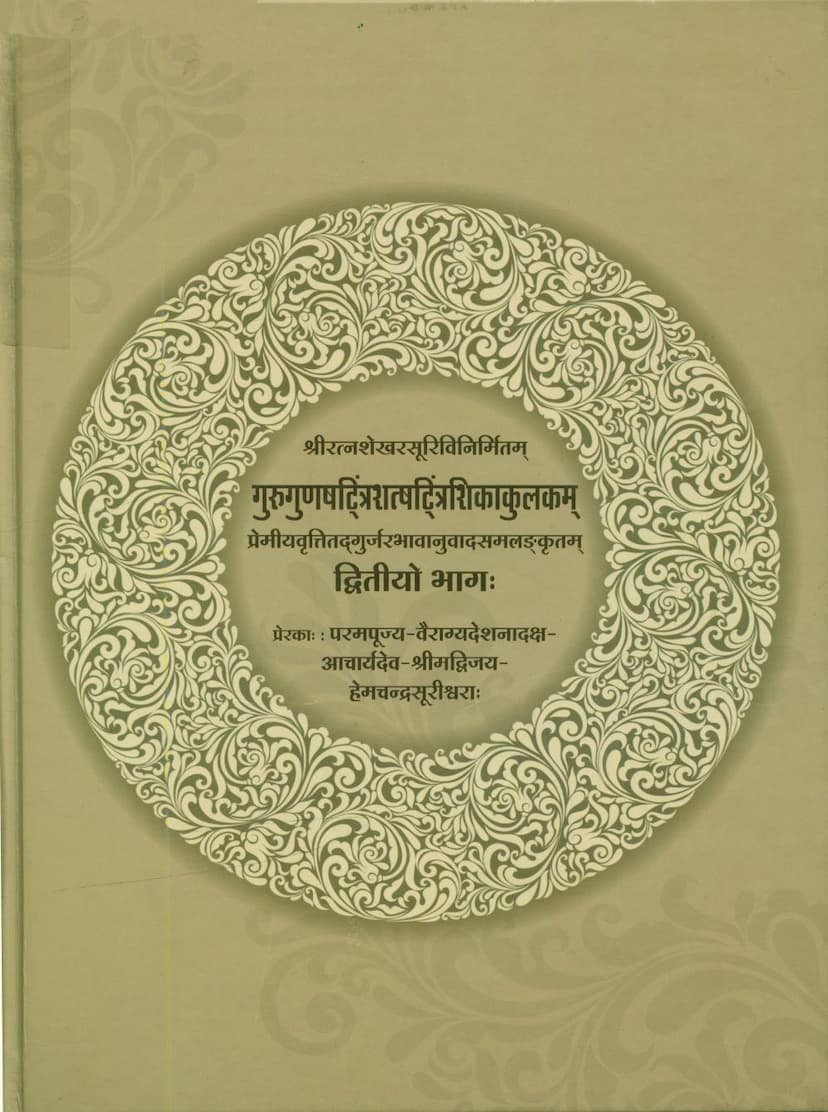Gurugun Shattrinshtshatrinshika Kulak Part 02
Added to library: September 1, 2025

Summary
The provided text is the second part of a Jain text titled "Gurugun Shattrinshtshatrinshika Kulak Part 02" authored by Ratnabodhivijay and published by Jinshasan Aradhana Trust. The catalog link is provided for reference. The text is intended for Jain education international and for private personal use only.
This volume focuses on the qualities of a Guru (spiritual teacher) as described in the "Gurugun Shattrinshtshatrinshika Kulak," originally composed by Shri Ratnashekhar Suri. The work includes a commentary in Sanskrit called "Premiya Vritti" and a Gujarati translation of its essence, both created by Muni Ratnabodhivijay, a disciple of Acharya Shri Vijay Hemchandrasurishwarji.
The book is structured into three parts, and this is the second part, containing the commentary and translation for verses 8 to 24 of the original work.
The introductory pages highlight the inspirational guidance of the revered Acharya Shri Vijay Hemchandrasurishwarji. The publishers, Jinshasan Aradhana Trust, express their gratitude to the Mulund Shwetambar Murtipujak Jain Sangh for their financial support in publishing this scripture. They also acknowledge the efforts of Akhilesh Mishraji for typesetting and Bhavinbhai of Shivkrupa Offset for printing, as well as Mukeshbhai of Multigraphics for the title design.
The preface, written by Muni Ratnabodhivijay, draws an analogy between a mother waking her child for school and a Guru waking souls from the slumber of delusion for spiritual progress. He explains that the original text by Shri Ratnashekhar Suri describes the thirty-six qualities of a Guru through thirty-six sets of thirty-six verses. Muni Ratnabodhivijay has further elaborated on this work by composing the "Premiya Vritti" in Sanskrit and its Gujarati translation for wider accessibility.
The second part of the book specifically details the following qualities and concepts of the Guru, divided into chapters (Shattrishikas or Chhattris):
- Seventh Shattrishika (Verse 8): Focuses on the Guru's knowledge of eight types of Karma, eight limbs of Yoga, eight great Siddhis, eight types of Yoga perspectives, and proficiency in four types of Anuyogas (commentaries/expositions).
- Eighth Shattrishika (Verse 9): Describes the Guru as one who knows the nine Tattvas (realities), is protected by nine Brahmacharya guptis (disciplines), is free from nine types of Nidanas (resolutions for future benefits), and practices nine types of Kalpa Vihara (approved modes of conduct).
- Ninth Shattrishika (Verse 10): Highlights the Guru's freedom from ten types of Asanvara (non-restraint), ten types of Sanklesha (mental afflictions), ten types of Upaghata (harm), and the six negative emotions (Hasya, Rati, Arati, Bhaya, Shoka, Jugupsa).
- Tenth Shattrishika (Verse 11): Details the Guru's adherence to ten types of Samachari (conduct rules), ten types of Chittasamadhi (mental concentration states), and freedom from sixteen Kashayas (passions).
- Eleventh Shattrishika (Verse 12): Describes the Guru's knowledge of ten types of Pratiseva (violations), ten types of Shodhi (confession/purification defects), and mastery of four types of Samadhi (concentration) beginning with Vinaya (respect).
- Twelfth Shattrishika (Verse 13): Emphasizes the Guru's practice of ten types of Vaiyavrittya (service), ten types of Vinaya (respect), ten types of Dharma (righteousness), and adherence to the six forbidden practices (Akalpa).
- Thirteenth Shattrishika (Verse 14): Focuses on the Guru's proficiency in ten types of Ruchi (inclinations/preferences), the twelve Angas (primary scriptures), twelve Upangas (secondary scriptures), and two types of Shiksha (training/learning).
- Fourteenth Shattrishika (Verse 15): Details the Guru's adherence to eleven specific vows or states of a lay follower (Shraddhapatima), twelve vows (of a lay follower), and thirteen types of Kriya (actions).
- Fifteenth Shattrishika (Verse 16): Highlights the Guru's knowledge of twelve types of Upayoga (conscious activities), ten types of Prayashchitta (penances), and mastery of fourteen types of Upakarana (accouterments).
- Sixteenth Shattrishika (Verse 17): Describes the Guru's continuous effort in twelve types of Tapas (austerities), twelve stages of spiritual development for monks (Bhikshu Pratimas), and twelve types of Bhavanas (meditations/reflections).
- Seventeenth Shattrishika (Verse 18): Mentions the Guru's mastery of fourteen Gunashthana (spiritual stages), fourteen qualities starting with Pratirupa (beauty), and proficiency in eight subtle spiritual states (Sukshma).
- Eighteenth Shattrishika (Verse 19): Details the Guru's adherence to fifteen types of Yoga, fifteen types of Samjna (consciousness/recognition), and avoidance of three types of Gaurava (pride/arrogance) and three types of Shalya (piercing inner issues).
- Nineteenth Shattrishika (Verse 20): Focuses on the Guru's practice of sixteen types of Uddama dosha (defects of arousal), sixteen types of Utpadana dosha (defects of origin), and adherence to four types of Abhigraha (vows).
- Twentieth Shattrishika (Verse 21): Highlights the Guru's knowledge of sixteen types of Vachana Vidhi (speech methods), engagement in seventeen types of Samyama (restraint), and freedom from three types of Viradhana (violations).
- Twenty-first Shattrishika (Verse 22): Describes the Guru's avoidance of eighteen defects related to initiating disciples, eighteen types of Papasthana (places of sin), and adherence to eighteen types of Sheelanga (limbs of virtue).
- Twenty-second Shattrishika (Verse 23): Emphasizes the Guru's practice of eighteen types of Brahmacharya (celibacy) and the eighteen thousand Sheelanga (limbs of virtue).
- Twenty-third Shattrishika (Verse 24): Mentions the Guru's freedom from nineteen Utkarsg dosha (defects of offering) and knowledge of seventeen types of Marana (death) and their methods.
The text provides detailed explanations and translations for each of these qualities, drawing from various Jain scriptures like Dashavaikalika Sutra, Pind Niryukti, Sthananga Sutra, Acharya Siddhasen Suri's commentary, and others. The commentary is attributed to Muni Ratnabodhivijay, who emphasizes the importance of understanding and internalizing these qualities for spiritual growth. The text also includes verses in Prakrit and their Gujarati translations.
The overall purpose of this part of the book is to provide a comprehensive understanding of the virtues and practices of a true spiritual guide in Jainism, enabling devotees to cultivate reverence and emulate these noble qualities.